BMW R1300 GS On and Off-Road Review: Still The Best All-Rounder?
The R1300 GS brings with it myriad advancements over the R1250, without losing what made that bike great
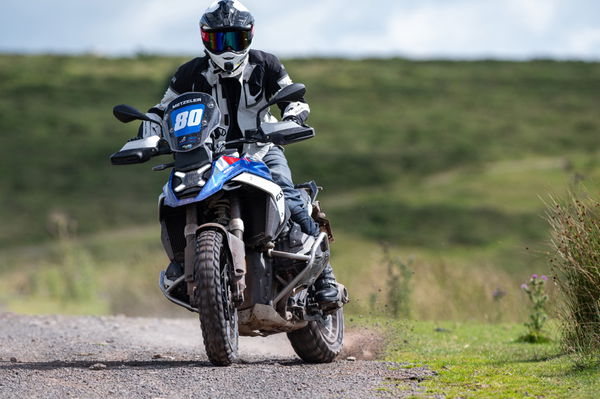
“Almost dainty” is how the BMW R1300 GS was referred to in the press release for the GS Adventure. We’re not sure we agree, but there has been a clear effort to distinguish the two bikes like never before, with the GSA taking on an aggressive, boxy look and the GS slimming down a little.
Naturally, the latter has led to accusations of it being ‘not a real GS’, which is nonsense. It takes everything great about the old model and refines it even further. Visordown group editor Matt rode the bike for thousands of miles across the UK, France, Austria and Germany to BMW Motorrad Days in Garmisch, while editor-at-large Toad tried the GS in Wales for some trail riding to see why BMW manages to sell so damn many.
R1300 GS engine, chassis and technology
The key change for the R1300 GS is hinted at in the name - an all-new, 1,300cc boxer twin. It uses Shift Cam variable valve technology and puts out 143bhp at 7,750rpm and 109lb ft of torque. Those figures might not ‘wow’ quite in the same way the stats of something like a Ducati Multistrada V4 or KTM 1290 Super Adventure might, but it’s a hugely flexible engine, with most of that torque available from just 3,600rpm.
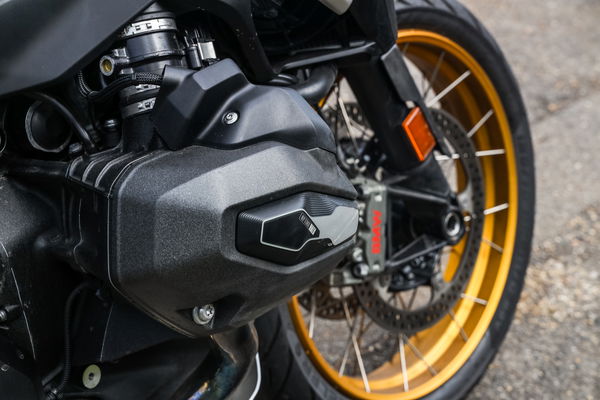
The twin has a higher compression ratio than before and a shorter stroke, making for a revvier attitude, but despite this and the uplift in power, the fuel economy has gone up a little to an official figure of 59mpg. The engine is also 6.9kg lighter than before, contributing to weight savings of around 12kg.
The bike still uses Telelever, one of a few weird front suspension systems we’ve covered elsewhere. This is the new Telelever Evo system which isolates the handlebars from the suspension to a greater degree than before, so suspension movements don’t corrupt the steering.
You get 190mm travel at the front and 200mm at the back from the Paralever setup. Optionally you can have the Electronic Dynamic Suspension Adjustment system with different levels of firmness for the damping, including adaptive height control. So, although the seat height isn’t the lowest at 850mm, this - combined with multiple seat options - means shorter riders are well catered for.
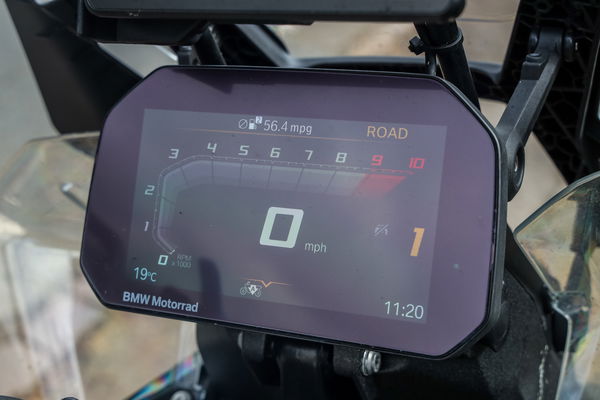
The bodywork is all new, with the asymmetric front light cluster replaced with a new X-shaped motif. There’s been quite a bit of moaning about this online, but it’s an improvement to our eyes.
What’s it like to ride on the road?
The self-levelling suspension makes the R1300 nice and easy to sling a leg over. As ever, firing it up gives that usual boxer quirk of the bike gently rocking side to side. When paddling the R1300 around it still feels like a chunky thing, but it’s spooky how all of that weight just fades away when the bike is ridden with a bit of enthusiasm.
Cornering always feels effortless. There’s a weird lack of drama to everything, even when you’re really pressing on. It’s a bike that doesn’t give you the biggest impression of speed, partly because of how refined everything is.
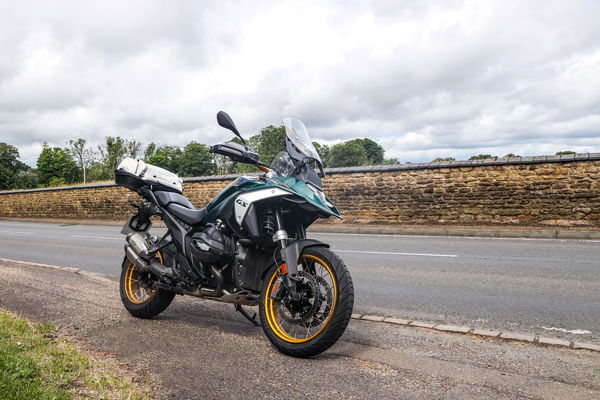
There’s a real plush quality to the damping, and there’s a noticeable difference between the firmer and softer settings of the adaptive setup. Slackening everything off makes for a silky smooth, continent-crushing machine that’ll soak up the worst surfaces while firming things up makes for a bike more eager to turn and less prone to diving/squatting under braking/heavy throttle inputs. It’s also yet another big adventure bike that doesn’t leave you wanting for a smaller front wheel. It turns just fine, even on a big 21-inch hoop ahead of you.
Such is that spread of mid-range torque, that it doesn’t really matter what gear you’re in. Whatever the revs, the R1300 GS will pull keenly and smoothly. It’s more eager to rev than you might think, though, with trips to the 9,000rpm redline proving very satisfying. It doesn’t, as you may expect for a boxer, run out of puff in its upper reaches.

The noise is going to be a love-it/hate-it thing. It’s just so different to a V-twin or a parallel, but after a week with the bike, we were really starting to appreciate the 1,300cc lump’s atypical growl. The only weaker point of the powertrain is the quickshifter - it’s not the smoothest and needs a fairly firm input to actuate.
When it comes to riding on tarmac, it’s on long motorway slogs where the GS really shines. Smooth suspension, excellent wind protection (even for taller riders) and slick adaptive cruise control make those dull bits you need to get out of the way to arrive at your twisty destination pass easily. Big days in the saddle are just more relaxing on this thing, further helped by an easygoing riding position.
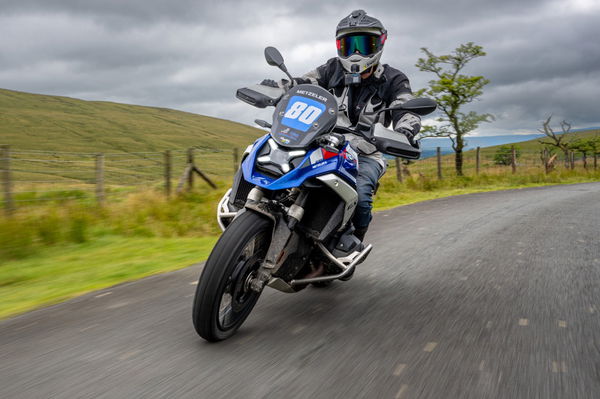
We’re on the fence about the multi-controller on the left handlebar. With it, you select what the adjacent rocker switch controls, choosing from things like the distance for the adaptive cruise, the heated seat/grips and the height of the electronically adjustable windscreen. It’s easy enough to use and declutters the cockpit, but a dedicated button for some oft-used functions like the heated grips might be nice, as the whole process is a bit of a faff.
The 6.5-inch TFT all of this works out of, though, is one of the best out there. Everything is nicely legible, and the fact it matches the fonts and styles of digital dashes from BMW car models is a neat touch, adding to the general premium feel of the bike.
Is the BMW R1300 GS any good off-road?
While Matt has covered what can only be described as an extensive on-road, touring review, I took the chance to visit BMW’s updated (and much swankier) Off-Road Skills (ORS) facility in Ystradgynlais, Wales. Here we were promised a day of fire trails, singletrack forest routes and lots and lots of mud.

The day began with a coffee and a catch-up with the ever-cheery Simon Pavey at the new ORS base. Here you now have a modern-looking showroom to allow the team to brief riders out of the rain before even donning their off-road boots. During the chat, Simon set out the course of the day, and it was clear from the onset that the new R1300 GS was going to be getting a very thorough test.
After a few miles of road riding, we hit our first off-road section, a sweeping and fairly quick gravel fire trail with a rocky and nadgery river crossing about a third of the way through. I’d barely had any time on the bike before being plunged into the river crossing, and it’s not like taking a 230kg bike across fast-flowing water is one of my favourite things to do. It was, though, a bit of a non-event, and save for some larger rocks at the bottom of the river kicking the ‘bars a bit, the Beemer hopped across without breaking a sweat.
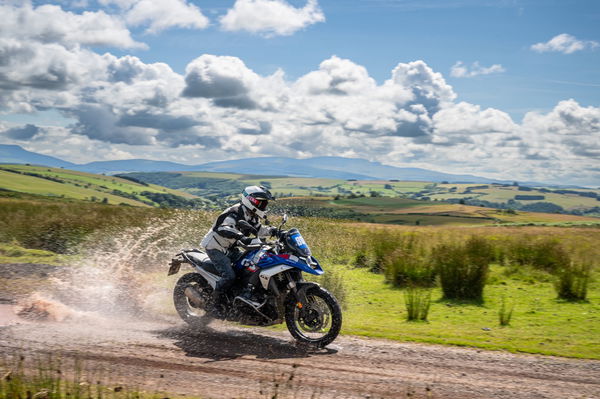
Part of the appeal of the previous generation 1250 powered bikes was the never-ending spread of low and mid-range grunt that could pull you up, over and through pretty much any obstacle. As expected, the updated 1,300cc engine only looks to build on this. When pushing on through deep water, mud and rocks, the torque of the bike just takes you where you need to go, and without the need to slip the clutch to keep the revs in the sweet spot, your upper body can totally focus on the act of controlling the bike.
The afternoon was spent enjoying some less technical and much wider, more sweeping trails, and I’m happy to report that one great element of the GS riding experience is very much still in evidence on the new bike. It’s the way that the low centre of gravity, thanks to the lump of Bavarian brawn stashed down low, makes faster riding on trails and tracks so satisfying and seemingly easy.
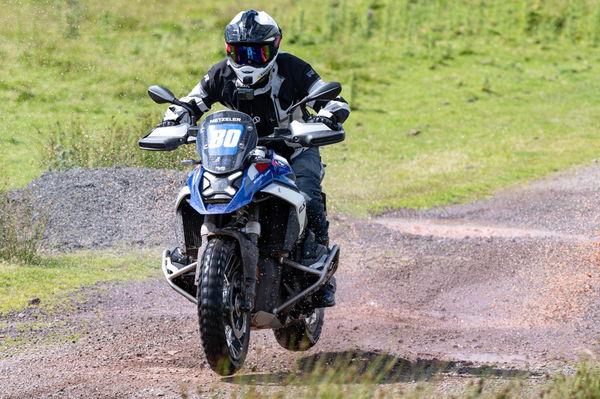
Bigger adventure bikes always seem to track so nicely off-road. They get kicked offline much less than smaller and lighter adventure and enduro machines, and generally, when you tell a big adventure bike which way to go, it’ll just go there with a minimal amount of fuss. The R1300 GS is probably the best at this, in that its stability and composure, regardless of what is going on beneath the wheels, really does feel second to none. There are probably wilder adventure bikes out there, KTM’s 1390 Super Adventure R springs to mind, but there are few that can match the BMW for its benign handling trait.
Probably the most revealing element of our day was the last section of trails, prior to heading back to the ORS base. Pulling us over at the side of the trail and in front of about 10 metres of muddy water, Simon Pavey explained what lay ahead. “We get a lot of 4x4s up here,” he said “and they tear up this trench. I have no idea which side is the best to go but it’s very deep. And please, for the love of god, don’t drown one of my bikes!” No pressure then Si!

After watching a few people take the left-hand side, and one of them nearly coming a cropper, I wussed out and opted for the right-hand side. As with any water crossing, slow in and fast(ish) out is the way to go, and with the bike in first gear and the Enduro Pro riding mode selected, I head in and gently build my speed. With my eyes locked on the other side of the trench, the only nervy moment was a hefty rock at the far end of the trench that kicked me up the backside with the bike’s seat, but the bike barely flinched.
At the other side of the obstacle, and with boots full of water, the tide line on the bike (and my riding trousers) confirmed the water was just teetering around the level of the bike’s LED indicators, and while I’m sure the bike could manage it, I’m not sure I’d like to go any deeper than that!
Should you buy a BMW R1300 GS?
Although we found for ourselves that the GS does very well for itself off-road, it’s on the asphalt where it truly shines. For bombing across multiple countries in one day and then providing more entertainment than you might expect at the other end, few bikes do it better.

The only problem is, you’ll need some fairly deep pockets. The bike starts at £16,470, but most will end up spending a lot more than that. Our test bike had the ‘Option 719’ ticked, which adds the gorgeous 'Tramuntana' Auerelius Green Metallic paint and gold wheels combination, a comfort seat, electric windscreen, pillion package and billet pack for an extra £2,820. Should you want to add the Dynamic Package on top of that to add the quickshifter and the adaptive suspension, it's an extra £1,660.
Get carried away in the configurator, and you can soon inflate the price beyond £25,000. Not exactly chump change, but the GS has never been a cheap bike, and in any case, BMW motorcycles live in a weird microcosm separate from much of the bike industry. People are happy to pay these prices, as proven by the R1300 GS consistently topping UK sales charts since it was introduced. After spending a few thousand miles on a new GS, we completely understand why.
Sponsored Content
Latest Reviews
More Reviews










